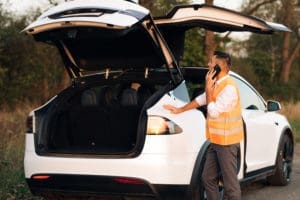EV sales grew by 36% in 2022, and while experts don’t forecast this same high level of growth for 2023, we are sure to see more and more electric vehicles on our roads. Environmentally focused individuals feel good about choosing battery electric vehicles and hybrid electric vehicles to reduce harmful emissions in the atmosphere. For towing businesses, however, this means operators must be trained to safely access and haul vehicles with different mechanics and electrical systems. Understanding how to tow an electric vehicle is critical as more of these cars and trucks hit the roads in your community.
 Does the car simply need a charge?
Does the car simply need a charge?
Just like drivers who own traditional vehicles and run out of gas, there are times when owners of electric vehicles run out of charge. Rather than towing the vehicle to the nearest charging station, there are portable charging units tow companies can use to recharge a battery wherever it is. Investing in this equipment is a valuable service you can provide to your customers and differentiate your business from the competition.
Avoid towing the vehicle on two wheels.
Electric vehicles are constructed very differently from traditional combustion-engine vehicles. The turning of the wheels on the road helps the vehicle generate electricity. Often, electric vehicles do not have a “neutral” gear, so towing a vehicle in this method can be very unsafe. A few models, like Teslas and the Nissan Leaf, have a transport mode that works similarly to neutral. However, the transport mode is meant for very short distances, like getting the vehicle onto a flatbed, not for the actual tow. Instead, all four EV wheels should be off the ground during a tow.
Use a flatbed to tow an electric vehicle.
The recommended method for towing electric vehicles is to use a flatbed tow truck. The first step is to check with the manufacturer’s recommendations to determine where to connect to the EV to load the vehicle onto the truck bed. Not all vehicles can be accessed at the same points. For example, some may require a towing eyelet, while others may need a tow hitch instead. Once on the flatbed, operators must evaluate the vehicle’s weight. Electric battery cells and equipment are much heavier than combustion engines. This means the EV is much heavier than a gasoline-powered vehicle of similar size. Even a small EV can weigh 5,000 pounds or more. Much of the weight is evenly distributed between the front and rear axles, unlike combustion engine vehicles that are often front-loaded.
Collins Manufacturing is your partner for safe towing equipment.
We are your partner for achieving success, whether that means using our world-class towing equipment or a flatbed tow truck. While you’re focused on running your business, allow our pros at Collins Manufacturing to introduce you to top-of-the-line towing equipment your employees and customers will love. Our Collins Manufacturing’s Hi-SpeedⓇ Dolly and Carrier Dolly systems are easy, safe to operate, light to transport, and durable to handle the toughest towing jobs. By providing our towing solutions for your employees, you’ll make their lives easier and see their job satisfaction grow. Collins has been an industry leader in towing equipment for over 45 years. Our Hi-SpeedⓇ Dolly and Carrier Dolly systems provide towing professionals with lightweight solutions durable enough to get even large vehicles out of challenging situations and transport them safely wherever they need to go. Our products are designed with safety first to keep your employees safe while attaching and moving vehicles. Visit our website or give us a call to learn more about our products.

Leave a Reply